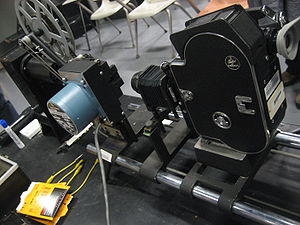- Optical printer
-
 A 35 mm optical printer with two projector heads, used in producing movie special effects. Starting from the left, you can see light shining from the lamp house, then at A is the first projector's film gate, at B a lens that projects the film in A onto the second projector's gate C. At D is the lens of the camera, the camera's finder is at E and the adjustable shutter control at F. The heavy base G contains all the electronics needed for controlling the printer.
A 35 mm optical printer with two projector heads, used in producing movie special effects. Starting from the left, you can see light shining from the lamp house, then at A is the first projector's film gate, at B a lens that projects the film in A onto the second projector's gate C. At D is the lens of the camera, the camera's finder is at E and the adjustable shutter control at F. The heavy base G contains all the electronics needed for controlling the printer.
 University at Buffalo's Department of Media Study 16 mm Optical Printer, constructed using a Bolex camera.
University at Buffalo's Department of Media Study 16 mm Optical Printer, constructed using a Bolex camera.
An optical printer is a device consisting of one or more film projectors mechanically linked to a movie camera. It allows filmmakers to re-photograph one or more strips of film. The optical printer is used for making special effects for motion pictures, or for copying and restoring old film material.
Common optical effects include fade outs and fade ins, dissolves, slow motion, fast motion, and matte work. More complicated work can involve dozens of elements, all combined into a single scene.
Contents
History
The first, simple optical printers were constructed early in the 1920s. Linwood G. Dunn expanded the concept in the 1930s, and the development continued well into the 1980s, when the printers were controlled with minicomputers. Prime examples of optical printing work include the matte work in 2001: A Space Odyssey and Star Wars.[citation needed]
In the late 1980s, digital compositing began to supplant optical effects. By the mid-nineties, computer graphics had evolved to rival and surpass what was possible with optical printers, and optical printing is now all but gone.[citation needed] Improvements in film scanners and recorders allow for a complete feature film to be processed by computers, have special effects applied, and then be processed back to film.
Today, optical printing is mostly used as an artistic tool by experimental film makers, or for educational purposes. As a technique, it is particularly useful for making copies of hand painted or physically manipulated film.[citation needed]
Artifacts
As in any analog process, every optical "pass" degraded the picture, just like a photocopy of a photocopy. Also, since a new, different piece of negative was exposed and printed, matching the exact colors of the original was a problem. For economical reasons, especially in the 1950s and later in TV series produced on film, printer work was limited to only the parts of a scene needing the effect. The original footage was spliced mid-shot with the optically-printed portion, resulting in an obvious change in image quality when the transition occurs.
Other problematic artifacts depend on the effect attempted, most often alignment inaccuracies in matte work. For this reason, shots intended to be manipulated via optical printer were often shot on larger film formats than the rest of the project. Larger film (such as the Vistavision format) has better clarity and less grain when reprinted and also reduces alignment problems.
See also
- Bipack
- Rear projection
- Schüfftan process
- Special effect
- Traveling matte
References
Categories:- Special effects
Wikimedia Foundation. 2010.
